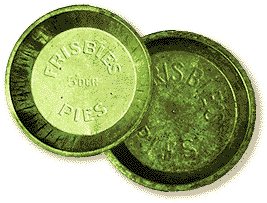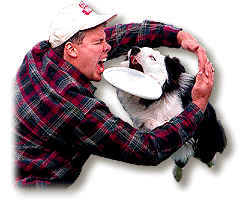
Go Ahead, Give It a Whirl
![]()
By Michael J. Weiss
![]()

![]()
By Michael J. Weiss
![]()
|
Sometimes a man just needs to take up a pie plate and hurl it. It might soar a great distance. It might crash into something. Either way
he is happy. We don't know for sure whether the young men at Yale who first began flinging pie plates through their hallowed halls were fulfilling this primordial need or just being jerks. But we do know that they yelled, "Frisb..ie...e...e...e...e" as a warning of sorts to anyone who was about to have his head dented by the flying metal disc. Why "Fris-bie...e...e...e?" Because the Frisbie Baking Company, of nearby Bridgeport, Conn., baked the pies that once filled the plates.
 Frisbee, it was once written, is a game for "jocks who hate jocks."
Nonetheless the Yalies still insist they did it first and, just in case, some go back as far as the 1820s when a Yale undergraduate named Elihu Frisbie reportedly was so offended by the passing of a collection tray in chapel that he seized it and flung it out into the campus. It caught on and soon, the story goes, the air was filled with collection plates. Powerful evidence, eh? Anyway we can say with absolute certainty that the Frisbee as we know it was born in 1948 when Walter Morrison, a California building inspector, created a plastic version of the pie tins he used to hurl. He named his first model the "Rotary Fingernail Clipper." It didn't seem to capture the public's imagination. Then hoping to cash in on the fascination with UFOs, he changed the name to the "Pluto Platter." The platter was a big hit when Morrison demonstrated it at county fairs or on California beaches. He even stamped simple instructions on each one: "Flat flip flies straight. Tilted flip curves. Play catch. Invent games." Still the platter didn't make him a rich man. That didn't come until 1957 when two USC grads named Rich Knerr and Arthur "Spud" Melin paid him $1 million for his invention.
 From tiny pie plates a giant counterculture grows.
The Sixties were very, very good to the Frisbee. It became the unofficial flying object of the revolution, a toy bursting with zen. What gathering of hippies would have been complete without one? What self-respecting counterculture male, publicly disdainful of establishment sports, wouldn't try to impress girls with the power of his Frisbee flip, the sureness of his catching hand? The folks at Wham-O realized they were on to something and began marketing their toy as a sport. In 1964 the first "Professional Model" Frisbee went on sale. Since then it's been one pretty smooth ride. Some highlights: 1967: High school students in Maplewood, New Jersey, invent Ultimate Frisbee. The cross between football, soccer and basketball is now a recognized sport on hundreds of college campuses and is very big in Europe. It's also one of 18 sports for which Boy Scouts can earn badges. 1968: The U.S. Navy spends almost $400,000 to study Frisbees in wind tunnels, follow their flights with computers and cameras, and build a special Frisbee-launching machine on top of a Utah cliff to test a prototype flare launcher. The research was not continued.
 A man and his dog and his disc 1991: More than 20,000 Frisbees are sent to Saudi Arabia to lift the morale of U.S. troops in Operation Desert Shield. Today Frisbee is only one of at least 60 different models of flying discs. And Wham-0 has sold Frisbee to Mattel. The Frisbie Baking Company is long gone now, too, but collectors still get a little unhinged over the old pie plates. Even the old plastic Frisbees are collectibles now. Some pre-1964 models are said to be worth $400. And why not? As Frisbee philosophers like to say: "When a ball dreams, it dreams it's a Frisbee." Think about it. If you have comments or a Frisbee anecdote to share, send them to rrieland@discovery.com.
Michael J. Weiss is an award-winning journalist, lecturer and marketing analyst. A contributing editor for Washingtonian and Ladies' Home Journal, he's the author of two books on American lifestyles:Latitudes & Attitudes and The Clustering of America. Give him feedback at MIKEJWEISS@aol.com.
Pictures: AP/Wide World Photos | David Tucker/Daytona Beach News Journal/ AP/Wide World Photos | Courtesy of Mattel | Matt Kryger/Elgin (Ill.) Courier News/ AP/Wide World Photos | Copyright © 1997 Discovery Communications, Inc. |